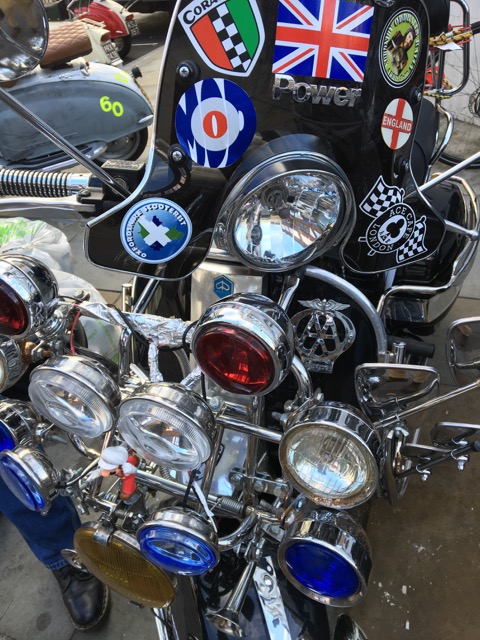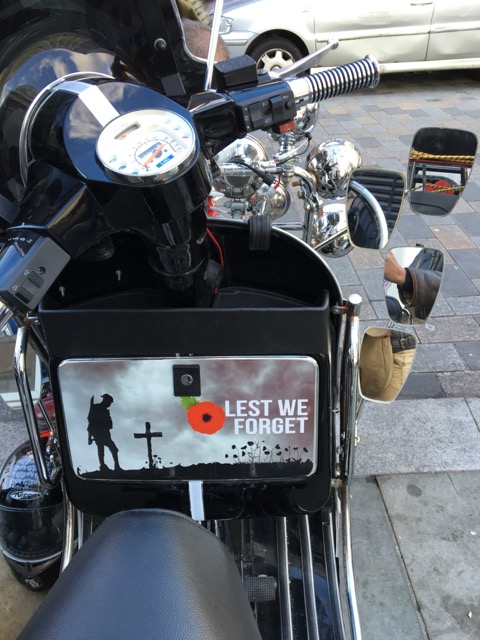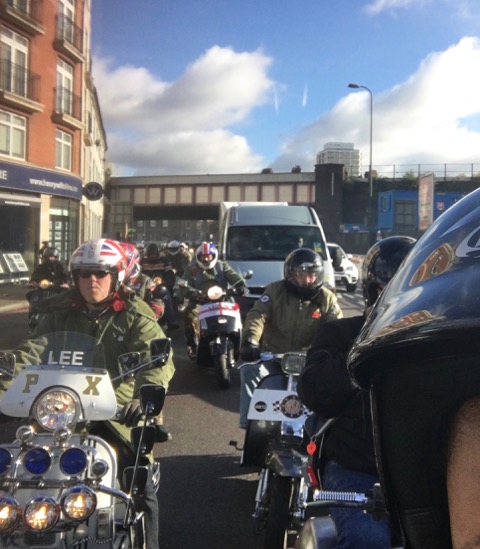
Diana Donaldson, Course Leader, Graduate Diploma in Fashion Media Styling, London College of Fashion
The research project ‘A Different Hue of Blue’ aims to expose the realities of embedding diversity and inclusivity within the curriculum of Higher Education courses. As a development initiative, written from the perspective of an educator of colour, the project uses constructive alignment (Biggs, 2014) to instigate a deeper enquiry-based journey and question perceived differences to enhance students’ academic, personal and professional development. Part of this project, the case study intervention described in this article entitled ‘Tribute’, is a two-pronged live intervention that began in the classroom, migrated into the public domain and became a pedagogic tool of great efficacy. By encouraging open discussions about race and stereotyping in the classroom, whilst tackling assumptions, prejudices and fears, this intervention provoked a sense of curiosity and motivated students to critically reflect on their belief systems.
diversity; assumption; curiosity; intervention; cultural appropriation; social stereotype
Autobiography, or self-life writing, can be a powerful tool not only for students in gaining perspective of their learning and knowledge, but also for the teachers whose aim it is to promote them. Stephen D. Brookfield refers to autobiographies as having the potential to be a powerful source of insight into the resolution of problems, to both teaching and learning in developing critical reflection (1995). This approach was applied to the case study described in this paper – the intervention ‘Tribute’.
As a creative industry professional and educator, I am active in promoting inclusivity within the curriculum and the creative industries. Changeable industry briefs are a natural part of the creative process and as a practitioner I respond to those changes spontaneously. The classroom seems very similar. Arguably a curriculum should consider inclusivity, so being diverse in nature is critical. There are a few initiatives on this subject, including ‘Shades of Noir’, which explicitly practice pedagogies of social justice (Hahn Tapper, 2013). However, the agenda that often drives such initiatives can become a convention rather than the vehicle for change that is required. As Richard Appignanesi comments, ‘cultural diversity is a managerial formula, an institutional agenda, and most pertinently, an instrument of governance. Cultural diversity is what happens to culture when it becomes a sector of politics’ (2010, p.6). ‘Tribute’ is not a student brief, nor is it an initiative embedded in the curriculum. It is an intervention created in real time to respond to an incident described below that took place in my classroom.
My experience suggests that attitudes and levels of low tolerance towards different cultural or community groups in society and the retention and attainment of students of colour, continues to be an issue within creative Higher Education (HE) and within creative institutions it is on the increase (Finnigan and Richards, 2016). The task of embedding authentic, informative and enduring change within the curriculum has never been more challenging and continues to be an imperative to the successful delivery of meaningful education.
My academic experience – spanning over 18 years teaching on MA Multimedia Design and postgraduate Fashion courses – has shown me that being a black educator is relevant for many reasons. One such reason is that academics of colour make up only 3.6% within the creative arts and design subjects (Loke, 2011, p.19). This data reinforces issues which I have experienced during my academic career, in that many students have never seen nor spoken to a person of colour, presenting challenges when we first meet in the classroom. Frequently I face prejudices and fears from both home and international students and classes are often filled with preconceptions based on cultural biases (Tate, 1997). For example, at some point during the course or unit most students question, test or challenge my qualification as an educator. This often takes the form of defiant behaviour or what Campbell and Manning term, ‘microaggressions’ (2014). These include asking me whether I am ‘qualified’ to judge what constitutes an MA project. Such negative assumptions are highlighted in an Equality Challenge Unit report on The Experience of Black and Minority Ethnic Staff in Higher Education in England (Loke, 2011), in which staff of colour reported doubts about their abilities: assumptions which they felt were directly connected to their ethnicity.
These are the circumstances which have led to a wider ongoing research project ‘A Different Hue of Blue’, which began in 2015. Sharing the reasons why I initiated the Tribute intervention and my experience of implementing that intervention in the classroom achieved a more open and truthful dialogue with students around sensitive subject matters related to race and stereotyping, whilst also tackling the multiple assumptions, prejudices and fears that they bring into classrooms, to learn about subjects that are equally as complex.
At the start of a course or unit the first brief I give my Fashion Media styling students is called ‘British Classics’ which is provocative by design. An important project, students are required to define a progressive definition of a British Classic embodied in an artefact and to create media styled images using the object. I measure the quality and efficiency of the research against the themes that emerge. For example they will typically identify classic heritage brands, the quintessentially British dandy; subcultures such as Mod and Skins from cult films like Franc Roddam’s Quadrophenia or Shane Meadows’ This is England and publications such as Subculture: The Meaning Of Style by Dick Hebdige. The brief asks them to analyse tradition against the current emerging identity and definition of British Culture. It pre-empts by design, stereotypes from all students and gives me an opportunity to demonstrate how to unpack some of the misconceptions that are an integral part of this process. Stereotypes are largely based on assumptions due to cultural terms of reference. Through this brief the notion of ‘Britishness’ is questioned and examined so that wider, multicultural, multiethnic contributions to contemporary British culture are not ignored. Furthermore, the British classics brief deliberates terms such as authenticity, assimilation and appropriation.
Primary research presents sometimes formidable individual interpretations through ‘authentic’ personal narratives. There is at times an over-emphasis upon preconceived ideas. For example, students presented some wildly colourful misconceptions and assumptions relating to iconic Mod and skinhead subcultures between the 1960s and 1980s. One of the most pronounced being, ‘Blacks and skinheads use to get on but something happened and then they fell out’. Though educators tend to shy away from sharing too many personal details with students, when it comes to topics such as these, my own personal insights and biography are a means of exploring this subject, enabling students to encounter different personal narratives woven into the subject they are researching. Growing up 5 minutes from the National Front HQ in Croydon in the 1980s, I knew and saw a darker side of what skins in particular, represented. Although many narratives state how skinhead culture was about working class empowerment and destabilising the status quo, in my experience it also symbolised a time of extreme racial antagonism and violence.
The project exploring the differences between historical subcultures, was deliberately chose to highlight the lack of research in this area. Even though students are aware that it is a significant part of the marking criteria and learning outcome of their course, many tend to be unmotivated to undertake independent research. There is much literature and multiple diverse research sources on these topics currently available, however students tend to fall back on generalisations that are naive at best, and, at worst, ignorant in ways that undermine the rigour and ethics so vital to academia. The research methodology and subject matter demonstrate the problems students face when consulting mainstream online and confirmation biased research which often lacks critical thinking and independent enquiry based learning. The fact that the political, cultural and historical significance of this subculture is largely ignored is something I could address verbally however this lacks impact so I used it as an opportunity to create an ‘intervention’. ‘Tribute’ was used as a means of encouraging deeper investigation in students – whilst simultaneously enriching dialogues relating to these subcultures, which are widely documented and misunderstood in equal measure.

Initially, the teaching intervention Tribute set out to teach by example and initiate direct contact with a subject. Following on from my ‘lead by example’ approach in-classroom, with an emphasis upon personal interaction and the primacy of autobiographical accounts at the forefront, my first aim was to arrange a meeting beyond the classroom, to enable students to speak to another reliable source in a safe and informal setting. I contacted friends, friends of friends, relevant organisations and enthusiasts involved in British Mod and skinhead scenes, past and present. After speaking to a few people, I met an individual who represented a dichotomy between both style and culture – a mixed race man called Steve. A meeting was set up so we could talk to Steve about his experiences, in an informal interview intended to supplement the students’ individual research projects. However already an hour late only a couple of students rang to say they would be even later and others failed to turn up. Understandably at that point Steve withdrew his offer to speak to the students.
After a lengthy apology, change of venue and discussion about the ‘youth of today’ Steve and I spoke. He shared much of his story. As a young mixed race Mod he grew up during a particularly volatile time in London in the 1980s, after the emergence of the National Front. He experienced racist attacks. For example he had the t-shirt ripped off his back by a neighbour, who had the misconception (shared by both Black and white people) that all Mods and skinheads are racist. Steve was quick to point out that many factions of Mods and skins maintained great friendships and commonalities with Black people and local communities. A love of popular culture, including music, was a unifying force.
Following this initial conversation with Steve, I met some of his friends and we shared our experiences, including the story behind the title of my research project – ‘A Different Hue of Blue’ – as the autobiographical motivation behind my teaching strategy. After encountering my first incident of racism as a child, my parents explained that people are people and they are all same colour beneath the skin: the colour I chose to imagine was blue. Blue and hues of blue symbolise for me the nuances of diverse people and individual relationships, different yet the same. With this ethos in mind and following a personal invitation from Steve and his friends, I had no hesitation in joining them when they invited me to participate the thousand strong scooter entourage of old school and modern day Mods and skinheads for their annual London ride to the Cenotaph Memorial in Whitehall for Remembrance Sunday in 2016 (pictured throughout this article in Figures 1–4). It was at this point I took the opportunity to turn research into intervention and called the intervention ‘Tribute’ – so named to reflect the gratitude and admiration for those being remembered at the Cenotaph also as a compelling representation of inclusivity.

Highly stylised customization and colourful paraphernalia adorn the scooters, an important part of the pop-cultural narratives and subject interpretations of tradition that converge in these subcultures. The Union Jack was a prominent feature and the multiple mirrors, lights and glorious shining chrome scooters adorned with Trojan, Northern Soul accessories, badges, stickers and poppies were a sight to behold. Brogues, Tassel Loafers, Penny Loafers and Doc Marten’s were polished to a high shine; coats, jackets and torn, bleached or aged denim. No two people looked the same. The attention to detail was extraordinary. The journey from Shoreditch to Waterloo, then on to the Cenotaph was sensational. There was sense of community as banter and rhetoric flowed until it was time to observe the two minute silence.


As the only female of colour in just a handful of women amongst hundreds of Mods and skins the mix could hardly be described as diverse, yet I felt at ease walking through the crowd, taking pictures and even got invited to another ride in the coming months. Stereotypes are damaging because people believe them, so the myth perpetuates and eventually presents as truth.
Having gathered these insights and experiences, I held a feedback session and shared the research process through interview excerpts, film and photographs of the ‘Tribute’ intervention. Students were in awe and regretful at missing out in equal measure. A part of my strategy to consolidate the class as a group is to identify similarities, strikingly in this case it was war. Given the context of my journey and public intervention, travelling to the Cenotaph, I used current and diverse dialogues around international conflict to open the session. The cohort shared their views on war and conflict resolution. The thought behind this strategy is that war is a common human theme. All students, either through direct experience or empathy, can respond to or at least have a view about it. Students agreed to disagree on causes and actions for certain conflicts but were united in concluding that loss of life is painful and pointless and that those willing to fight for freedom are courageous.
When discussing the historical context of the Cenotaph, I told students that I considered the honour of all soldiers to be one of the most truthful examples, a tribute to diverse inclusion, irrespective of race. Soldiers fought and died together. A wider discussion ensued. Students began opening up and comments included:
‘Were you scared?’
‘Where do you find your courage?’
‘Were you the only dark skinned (Black) person there?’
‘How exciting! The pictures are amazing. This kind of research is really interesting.’
After establishing the question of fear which in this instance was based on a perceived stereotype, I was able to demonstrate how assumptions can be detrimental to critical thinking. As I explained, I believe I am open to such experiences due to my upbringing, because everyday experiences demand courage. This courage is no different to walking into studios, classes or meetings for me as I tend to be a minority in those situations. This encouraged them to consider how many may feel a similar sense of trepidation walking into a class at any given time, it is not so different just because they are students. Revealingly, the student who had made the earlier comment that prompted this whole intervention, ‘Blacks and skinheads use to get on but something happened and then they fell out.’ revealed his embarrassment and apologised.
We then discussed how his comments demonstrated critical reflection and growth. Also that as creatives we collaborate, which is why we have a responsibility to understand a wider context. Students then initiated a candid and stimulating debate around the various misconceptions they had about one another, about other nationalities and myself, but more importantly they were not afraid to share their thoughts and concluded at a point of commonality whereby they agreed that assumption can be damaging. They were surprised that they all had misconceptions about each other so no one opinion was superior, and that it is important to listen to individual narratives.
‘Tribute: an autobiographical classroom intervention’ was then presented as part of the UAL Learning and Teaching Day, held at Central Saint Martins in March 2017. The response was extremely positive. Questions from participants included:
‘What about the implications of students engaging in primary research in terms of safety?’
‘Would you advocate primary research being used to help embed diversity and inclusivity within the curriculum?’
‘Effective intervention, but how do we make the time?’
The issue of safety is an ethical one and there are very clear guidelines in terms of ethical policy in the UAL Code of Practice on Research Ethics (2017). Students collaborate and or seek external verification of their ideas and work, using the same principles adopted by all UAL researchers when undertaking primary research and collaboration, which require external verification. When assigning the research intervention, students are briefed on how to gauge hazards by completing a full Research Ethics Risk Assessment and must gain approval. It is ensured that all students understand that they must act responsibly towards themselves and others. The ‘Tribute’ intervention gave me the opportunity to raise the subject of ethical responsibility. Citing their laissez-faire attitude towards the initial interview with Steve I referenced the Code of Practice on Research Ethics, and drew their attention to sections on ‘Guiding Principles’ as well as ‘Obligations and Responsibilities’.
In response to another comment from the Learning and Teaching Day, I do not advocate primary research as a way of embedding diversity within the curriculum. From my experience, primary research is an organic and intuitive process. As a method, Tribute uses primary research to ignite a curiosity for diverse research. Although primary research is the starting point they will invariably find themselves inspired to conduct secondary reading and to follow up findings. Of the 20 students from LCF Fashion Media Styling Students and the CSM MA students in my tutorial group whom I also shared the Tribute intervention with, 18 included some form of primary research in subsequent submissions, and none had done so previously. Further to this, many made explicit references to my intervention in their learning logs (LCF) and reflective journals (CSM).
Finally, with respect to the question of time something many educators do not have much of, I would argue that finding space and opening the curriculum in a manner like that described here is a matter of priority, imagination and willingness to cultivate change.
As educators with sometimes overbearing schedules, agendas such as diversity and inclusion can be lost in the plethora of increasing duties and responsibilities we undertake, resulting in tokenistic measures to tick a box, yet we are increasingly asked to encourage students to engage with such agendas. Practicing what I teach has paid huge dividends to my students, even when these practices involve broaching difficult topics and inhabiting uncomfortable spaces. These dividends in turn keep me motivated. Having an awareness of the complex dynamics of a cohort is not only beneficial for students but also for the educator.
When teaching, there are always openings for interventions. Creating activities that address contentious issues in real time, often by subversion, to encourage explicit dialogue is a useful way to include such topics alongside the subjects we teach. Simple interventions make a distinct difference to the performance and practical outcome of students’ work and their life experience. Most importantly I have numerous testimonials and visual evidence of the enduring impact and inspiration these experiences have in terms of personal and professional development beyond university life. This case study, ‘Tribute: an autobiographical classroom intervention’, is one example from within in my wider curriculum development research, A Different Hue of Blue. It demonstrates directly how the smallest of interventions can have a significant impact.
Appignanesi, R. (ed.) (2010) Beyond cultural diversity: the case for creativity. London: Third Text.
Biggs, J. (2014) ‘Constructive alignment in university teaching’, HERDSA Review of Higher Education, 1(1), pp.5–22. Available at: http://herdsa.org.au/herdsa-review-higher-education-vol-1/5-22 (Accessed: 3 July 2017).
Brookfield, S. (1995) ‘The getting of wisdom: what critically reflective teaching is and why it’s important’ in Becoming a critically reflective teacher. San Francisco: Jossey-Bass, pp.1–28.
Campbell, B. and Manning, J. (2014) ‘Microaggression and moral cultures’, Comparative Sociology,13(6), pp.692–726. https://doi.org/10.1163/15691330-12341332.
Finnigan, T. and Richards, A. (2016) Retention and attainment in the disciplines: art and design. London: Higher Education Academy and University of the Arts London. Available at: https://www.heacademy.ac.uk/system/files/ug_retention_and_attainment_in_art_and_design2.pdf (Accessed: 3 July 2017).
Hahn Tapper, A.J. (2013) ‘A pedagogy of social justice education: social identity theory, intersectionality, and empowerment’, Conflict Resolution Quarterly, 30(4), pp.411–445. http://dx.doi.org/10.1002/crq.21072.
Loke, G. (ed.) (2011) The Experience of Black and Minority Ethnic Staff in Higher Education in England. London: Equality Challenge Unit. Available at: http://www.ecu.ac.uk/wp-content/uploads/external/experience-of-bme-staff-in-he-final-report.pdf (Accessed: 3 July 2017).
Parsons. J. (2015) ‘An introduction/review of action research and its ethical practices’, Canadian Review for Teacher Research, 30 May. Available at: http://www.teacherresearch.ca/blog/article/2015/05/30/264-an-introductionreview-of-action-research-and-its-ethical-practices (Accessed: 3 July 2017).
Shades of Noir (2017). Shades of Noir. Available at: http://shadesofnoir.org.uk/ (Accessed: 16 July 2017).
Tate, W.F. (1997) ‘Chapter 4: critical race theory and education: history, theory, and implications’, Review of Research in Education, 22(1), pp.195–247. https://doi.org/10.3102/0091732X022001195.
University of the Arts London (2017) UAL code of practice on research ethics. Available at: http://www.arts.ac.uk/media/arts/research/documents/UAL-Code-of-Practice-on-Research--Ethics-February-2017.pdf (Accessed: 3 July 2017).
Diana Donaldson is Course Leader of the Graduate Diploma in Fashion Media Styling at London College of Fashion and an Associate Lecturer at Central Saint Martins. With a lifelong passion and involvement in the arts, Diana’s experience as a creative stylist and style consultant in allied disciplines such as film, television, editorial, catwalk and personal styling spans over 16 years in the UK, Europe, United States and Asia. Her versatility as a creative stylist is exemplified through her work with high profile celebrity clients and global brands. She is also active in producing projects for the charitable and HE sector. Diana has a multi-faceted approach as an educator and has maintained a role in education alongside her professional industry practice - as stylist, style consultant, fashion editor and art director.